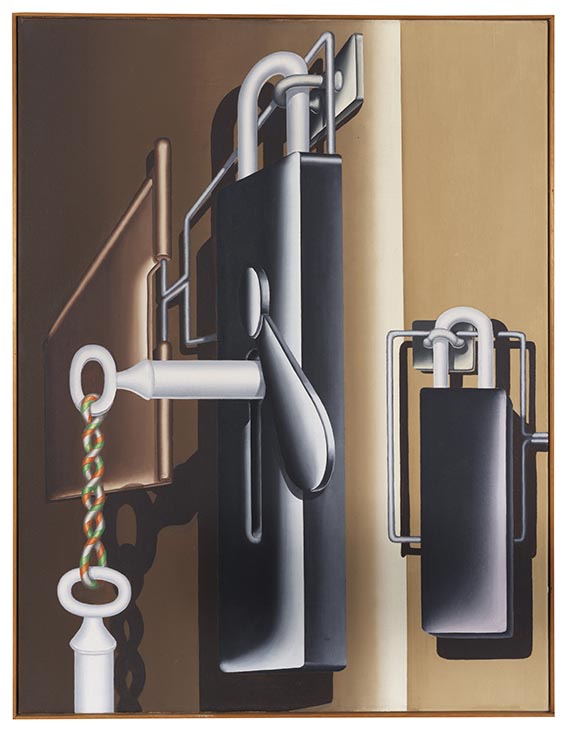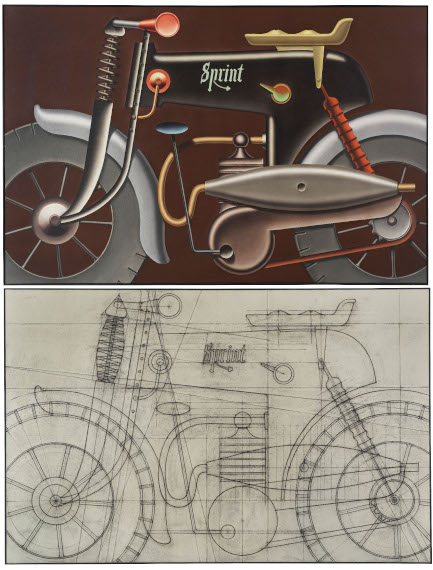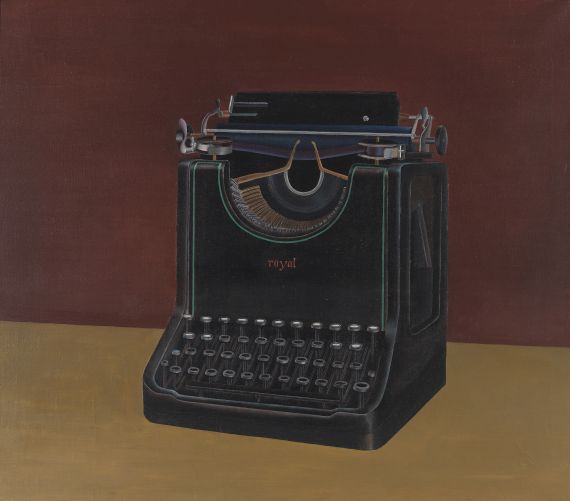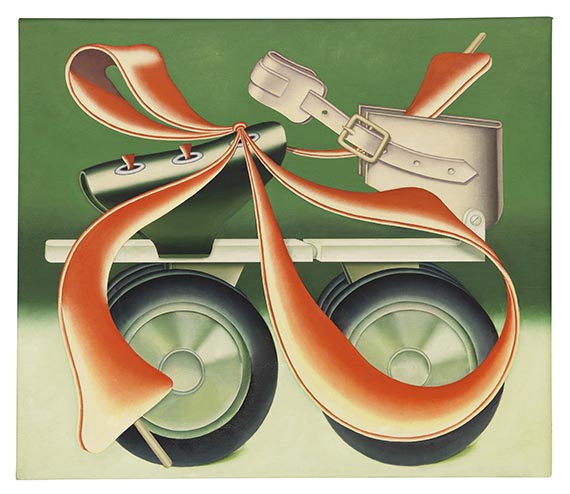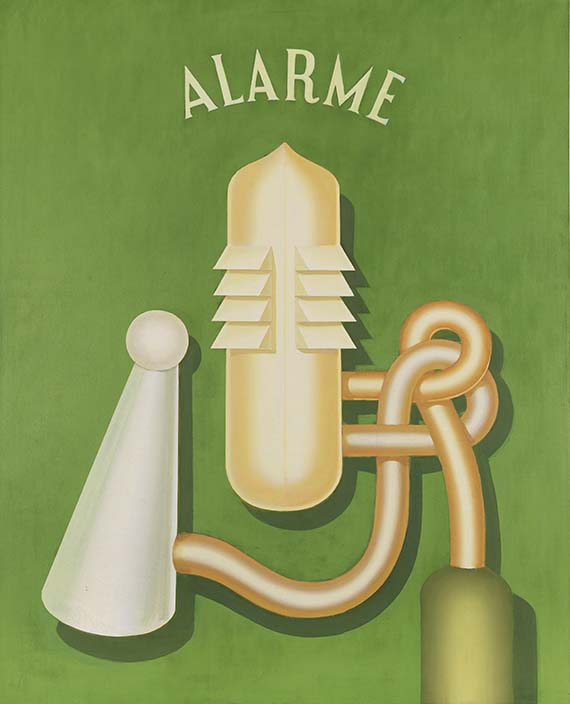Sale: 550 / Evening Sale, June 07. 2024 in Munich  Lot 124000240
Lot 124000240
 Lot 124000240
Lot 124000240
124000240
Konrad Klapheck
Die Technik der Eroberung, 1965.
Oil on canvas
Estimate:
€ 180,000 - 240,000
$ 192,600 - 256,800
Information on buyer's premium, taxation and resale right compensation will be available four weeks before the auction.
Die Technik der Eroberung. 1965.
Oil on canvas.
Signed and dated on the reverse. 90 x 70 cm (35.4 x 27.5 in). [JS].
• Klapheck is regarded both inventor and master of the "machine image", which he sees as a mirror of human existence.
• Klapheck's oeuvre, consisting exclusively of character objects, has anticipated elements of Pop Art and Photorealism since the 1950s.
• One of the rare early paintings in Klapheck's henceforth characteristic "hyper-representationalism".
• "Die Technik der Eroberung" (The Technique of Conquest) - a masterly staged surreal play of spatial confusion as a symbol of a sensual-erotic quest.
• Shown in several important Klapheck exhibitions since 1966, among others, at the Museum Boymans van Beuningen, Rotterdam/Kunsthalle Düsseldorf (1974/75) and the Kunsthalle Hamburg/Kunsthalle Tübingen (1985/86).
• Part of a private collection in Southern Germany for over 50 years.
The work is registered in the artist's archive under number 146.
PROVENANCE: Galerie Rudolf Zwirner, Cologne.
Private collection Southern Germany (acquired from the above around 1970, ever since family-owned).
EXHIBITION: Konrad Klapheck, Kestner Gesellschaft, Hannover, November 11 - December 11, 1966, cat. no. 146 (with the label on the rear of the frame).
Konrad Klapheck, Museum Boymans-van Beuningen, Rotterdam, September 14 - November 3, 1974 (with the label on the rear of the frame), Paleis voor Schone Kunsten, Brüssel, November 14, 1974 - January 5, 1975, Städtische Kunsthalle, Düsseldorf February 15 - March 31, 1975, cat. no. 49.
Konrad Klapheck. Retrospektive 1955-1985, Hamburger Kunsthalle, October 4 - November 24, 1985, Kunsthalle Tübingen, September 4 - February 9, 1986, Staatsgalerie moderner Kunst, Munich, February 21 - April 13, 1986, Munich 1985, p. 82, cat. no. 25 (illu. on p. 83).
Konrad Klapheck, David Zwirner, New York, November 8 - December 22, 2007 (with the shipping label on the rear of the frame).
"I try to give my pictures a smooth surface, I want them to look as if they were not made by man. I cover my passions with a layer of ice to make them last longer."
Konrad Klapheck, Meine Malerei, 1972.
"What distinguishes him [Klapheck] from the photo-realists [..] is the decisive change that takes place between object and image, the high degree of abstraction his objects have, their detachment from the natural environment and thus - despite everything - their distance from reality, their fetish character, their emblematic stylization. But all of this means that Klapheck's pictures must neither to be confused with what others do nor with what they represent."
Werner Schmalenbach, 1976, quoted from: Konrad Klapheck. Objekte zwischen Fetisch und Libido, Basel, Galerie Beyeler 1976, no p.
Oil on canvas.
Signed and dated on the reverse. 90 x 70 cm (35.4 x 27.5 in). [JS].
• Klapheck is regarded both inventor and master of the "machine image", which he sees as a mirror of human existence.
• Klapheck's oeuvre, consisting exclusively of character objects, has anticipated elements of Pop Art and Photorealism since the 1950s.
• One of the rare early paintings in Klapheck's henceforth characteristic "hyper-representationalism".
• "Die Technik der Eroberung" (The Technique of Conquest) - a masterly staged surreal play of spatial confusion as a symbol of a sensual-erotic quest.
• Shown in several important Klapheck exhibitions since 1966, among others, at the Museum Boymans van Beuningen, Rotterdam/Kunsthalle Düsseldorf (1974/75) and the Kunsthalle Hamburg/Kunsthalle Tübingen (1985/86).
• Part of a private collection in Southern Germany for over 50 years.
The work is registered in the artist's archive under number 146.
PROVENANCE: Galerie Rudolf Zwirner, Cologne.
Private collection Southern Germany (acquired from the above around 1970, ever since family-owned).
EXHIBITION: Konrad Klapheck, Kestner Gesellschaft, Hannover, November 11 - December 11, 1966, cat. no. 146 (with the label on the rear of the frame).
Konrad Klapheck, Museum Boymans-van Beuningen, Rotterdam, September 14 - November 3, 1974 (with the label on the rear of the frame), Paleis voor Schone Kunsten, Brüssel, November 14, 1974 - January 5, 1975, Städtische Kunsthalle, Düsseldorf February 15 - March 31, 1975, cat. no. 49.
Konrad Klapheck. Retrospektive 1955-1985, Hamburger Kunsthalle, October 4 - November 24, 1985, Kunsthalle Tübingen, September 4 - February 9, 1986, Staatsgalerie moderner Kunst, Munich, February 21 - April 13, 1986, Munich 1985, p. 82, cat. no. 25 (illu. on p. 83).
Konrad Klapheck, David Zwirner, New York, November 8 - December 22, 2007 (with the shipping label on the rear of the frame).
"I try to give my pictures a smooth surface, I want them to look as if they were not made by man. I cover my passions with a layer of ice to make them last longer."
Konrad Klapheck, Meine Malerei, 1972.
"What distinguishes him [Klapheck] from the photo-realists [..] is the decisive change that takes place between object and image, the high degree of abstraction his objects have, their detachment from the natural environment and thus - despite everything - their distance from reality, their fetish character, their emblematic stylization. But all of this means that Klapheck's pictures must neither to be confused with what others do nor with what they represent."
Werner Schmalenbach, 1976, quoted from: Konrad Klapheck. Objekte zwischen Fetisch und Libido, Basel, Galerie Beyeler 1976, no p.
Konrad Klapheck and the unique "sound" of his picturesseiner Bilder
Works of art are not only products, but also mirror of human imagination. They are characters that not only reveal the artist's pictorial language and characteristic sense of form and color, but also provide insight into the spiritual and emotional world of their creators. In an interview, the Hamburg painter Daniel Richter once emphasized how absolutely underestimated and difficult it is for a painter to find his own "sound". It is about this unmistakably individual character, the intrinsic value of form and content gained from the same painterly means of color and canvas. The struggle to fill the white canvas, at least in part, with something new and unique. That characteristic feeling that resonates in every work and gives the entire painterly oeuvre of an artist its unmistakable character. As soon as an artist succeeds in freeing himself from the shackles of art-historical traditions and is confident enough to dare to create something that is completely his own, the result is usually of a very special quality.
In this sense, Konrad Klapheck is an outstanding artist. The objects he placed on the canvas in a surreal, hyper-representational manner resemble modern symbols due to their great associative density, and have a completely unmistakable character and incomparable modernity, both in terms of form and content. From the 1950s onwards, Klapheck brought his very own "sound" to the canvas in a perfectionistic fine painting style. He reamined true to figuration in an environment dominated by gestural abstraction and, in the combination of painted subject matter, alienating elements and human-emotional titles, preserved personal and existential worlds ranging from childhood memories to abstract ideas of afterlife.
This present early painting with the evocative title "Die Technik der Eroberung" (The Technique of Conquest) is one of the rare works in which Klapheck explores the themes of love and eroticism in a cool "hyper-representational" manner, as it is also the case in the painting "Alphabet der Leidenschaft" (Alphabet of Passion) from 1961, which featured in the exhibition "Surrealism Beyond Borders" at Tate Modern, London, in 2022. In the "Die Technik der Eroberung", Klapheck masterfully succeeds in creating a surreal spatial confusion as a symbol of a sensual-erotic quest. In formal terms, Klapheck says he received important inspiration for this work from the imagery of contemporary animated films such as "Tom and Jerry": "There are lovely scenes in which the mouse has to climb up and get into a door lock in order to operate the mechanism with his teeth, and the door pops open spectacularly." ( quoted from: Konrad Klapheck, exh. cat. Museum Boymans van Beuningen, Rotterdam 1974, p.118). In the richly associative imagery of lock and key, Klapheck confronts us with the desperate search for love and emotional fulfillment, with the existential striving to overcome one's own loneliness in a fulfilling partnership. Klapheck's paintings - with the exception of his late figurative works - are always without people, yet they touch us in a very direct way; they are - despite their cool precision - the essence of human thought and feeling. In "Die Technik der Eroberung", Klapheck has achieved the seemingly impossible: Completely devoid of people, he stages an erotically charged game of confusion that - after successfully overcoming numerous obstacles - carries the hope of fulfillment.
Konrad Klapheck - painterly perfection with a cool and casual aura
Konrad Klapheck not only gave a soul to his objects, but also to his painting, turning them into fascinating complex depictions of abstract thought processes and emotional worlds. His "machine paintings" made Klapheck, who did largely without direct depictions of people, a painter of humanity. The unique aura his paintings emanate must be experienced both visually and emotionally. In their technical perfection, entirely free from traces of any manual style, Klapheck's paintings seem to have fallen from the sky. Based on meticulously thought-out preparatory drawings, they give no hint of their laborious, extremely meticulous creative process, but rather fascinate us to this day with their unique and cool aura. [JS]
Works of art are not only products, but also mirror of human imagination. They are characters that not only reveal the artist's pictorial language and characteristic sense of form and color, but also provide insight into the spiritual and emotional world of their creators. In an interview, the Hamburg painter Daniel Richter once emphasized how absolutely underestimated and difficult it is for a painter to find his own "sound". It is about this unmistakably individual character, the intrinsic value of form and content gained from the same painterly means of color and canvas. The struggle to fill the white canvas, at least in part, with something new and unique. That characteristic feeling that resonates in every work and gives the entire painterly oeuvre of an artist its unmistakable character. As soon as an artist succeeds in freeing himself from the shackles of art-historical traditions and is confident enough to dare to create something that is completely his own, the result is usually of a very special quality.
In this sense, Konrad Klapheck is an outstanding artist. The objects he placed on the canvas in a surreal, hyper-representational manner resemble modern symbols due to their great associative density, and have a completely unmistakable character and incomparable modernity, both in terms of form and content. From the 1950s onwards, Klapheck brought his very own "sound" to the canvas in a perfectionistic fine painting style. He reamined true to figuration in an environment dominated by gestural abstraction and, in the combination of painted subject matter, alienating elements and human-emotional titles, preserved personal and existential worlds ranging from childhood memories to abstract ideas of afterlife.
This present early painting with the evocative title "Die Technik der Eroberung" (The Technique of Conquest) is one of the rare works in which Klapheck explores the themes of love and eroticism in a cool "hyper-representational" manner, as it is also the case in the painting "Alphabet der Leidenschaft" (Alphabet of Passion) from 1961, which featured in the exhibition "Surrealism Beyond Borders" at Tate Modern, London, in 2022. In the "Die Technik der Eroberung", Klapheck masterfully succeeds in creating a surreal spatial confusion as a symbol of a sensual-erotic quest. In formal terms, Klapheck says he received important inspiration for this work from the imagery of contemporary animated films such as "Tom and Jerry": "There are lovely scenes in which the mouse has to climb up and get into a door lock in order to operate the mechanism with his teeth, and the door pops open spectacularly." ( quoted from: Konrad Klapheck, exh. cat. Museum Boymans van Beuningen, Rotterdam 1974, p.118). In the richly associative imagery of lock and key, Klapheck confronts us with the desperate search for love and emotional fulfillment, with the existential striving to overcome one's own loneliness in a fulfilling partnership. Klapheck's paintings - with the exception of his late figurative works - are always without people, yet they touch us in a very direct way; they are - despite their cool precision - the essence of human thought and feeling. In "Die Technik der Eroberung", Klapheck has achieved the seemingly impossible: Completely devoid of people, he stages an erotically charged game of confusion that - after successfully overcoming numerous obstacles - carries the hope of fulfillment.
Konrad Klapheck - painterly perfection with a cool and casual aura
Konrad Klapheck not only gave a soul to his objects, but also to his painting, turning them into fascinating complex depictions of abstract thought processes and emotional worlds. His "machine paintings" made Klapheck, who did largely without direct depictions of people, a painter of humanity. The unique aura his paintings emanate must be experienced both visually and emotionally. In their technical perfection, entirely free from traces of any manual style, Klapheck's paintings seem to have fallen from the sky. Based on meticulously thought-out preparatory drawings, they give no hint of their laborious, extremely meticulous creative process, but rather fascinate us to this day with their unique and cool aura. [JS]
124000240
Konrad Klapheck
Die Technik der Eroberung, 1965.
Oil on canvas
Estimate:
€ 180,000 - 240,000
$ 192,600 - 256,800
Information on buyer's premium, taxation and resale right compensation will be available four weeks before the auction.




